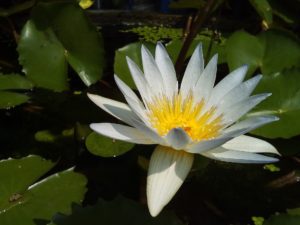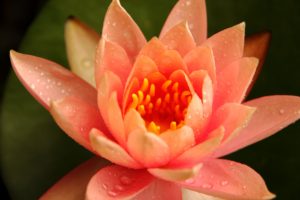Satipatthana Vipassana is the methodical practice of contemplating the four foundations of mindfulness:
- body (sensations, postures and activities),
- feeling (pleasant, unpleasant and neutral, sensual and spiritual),
- mind states (emotions, moods and quality),
- mind objects (sense perceptions, and thought phenomena).
A retreat with Anthony offers the supporting conditions, intensive structure and personal guidance for meditators to directly and intuitively experience insight into the conditioned nature of the mind-and-body – VIPASSANA.
Purpose of Vipassana Meditation
Satipatthana is the Buddha’s meditation technique that leads to vipassana insight. By practicing mindfulness meditation we become more aware of the sense of ‘me’, ‘mine’ and ‘I’. Vipassana or ‘clear-seeing’ is the way to reduce and remove this ‘sense-of-self’ from our experience. It is the way to see: ‘attachment is the root of suffering’.
By ‘seeing-clearly’ we stop taking our experience so personally. With vipassana, we begin to see unpleasant feelings and emotions – stress, criticism, fear, grief, loss, depression or anxiety – in a less personal way. We start to understand that our worries, concerns, beliefs and disappointments are ‘not mine’. We understand that more ‘ego’ means more suffering.
- if we wrongly appropriate a problem as ‘my’ problem – there is suffering (craving)
- If we wrongly believe that this pattern ‘is how I am’ – there is suffering (conceit)
- if we wrongly identify with an experience as ‘part of me’ – there is suffering (views)
Attachment begins to drop away. We start to taste freedom. We let go of the body, feeling, emotions and thoughts. We create space around them. The disease of ego dissolves when we do not identify with objects of experience. The more space we give – the more we let go – the happier we are. Vipassana leads to happiness.
A vipassana retreat is the opportunity to directly observe this process. To know and see clearly the arising of suffering. Vipassana releases us from suffering, step-by-step. It is the path to freedom from the mistaken view of ‘self-identity’. The goal of the Buddha’s Teaching is the complete end of suffering. Vipassana leads to the complete end of suffering.
Vipassana insights are conditioned phenomena. Meditation practice is simply putting the right conditions in place. It is cause and effect. If you practice correctly and the conditions are present – the truth of nature unfolds naturally.
Structure and elements of the retreat
The various elements of the nine-day vipassana retreats are like the ingredients in a good meal. They work together to create the best meditation environment possible. Each element performs a different function. When practiced together they greatly assist vipassana. Their benefits may not be apparent at first sight, so examination of them is helpful. These elements are the causes and conditions for a successful retreat experience.
 Daily Schedule
Daily Schedule- Moral Virtue
- Sense Restraint
- Right Attitude
- Noble Silence
- Meditation Instructions
- Dhamma Teachings
- Personal Interviews
- Sitting Meditation
- Walking meditation
- Daily Activities
- Mindful Yoga
- Pali Chanting
Daily schedule
Whilst on retreat it is important to strictly follow the retreat schedule, embracing it, and dropping any resistance to its structure. Learn to surrender and ‘go with the flow’ of the schedule. It is a skill that experienced meditators know and follow. Observe the ‘little voice inside’ telling you skip a session! Maintain your determination in a relaxed way. There are 7½ hours of formal meditation daily. Pace yourself. Be prepared. It is not difficult, but does require discipline.
| 4:30 a.m. | Wake-up / Wash |
| 5:00 – 5:45 a.m. | Sitting meditation |
| 5:45 – 6:45 a.m. | Mindful yoga |
| 6:45 – 7:30 a.m. | Sitting meditation |
| 7:30 – 9:00 a.m. | Breakfast / Chores |
| 9:00 – 10:00 a.m. | Meditation Instructions |
| 10:00 – 10:45 a.m. | Walking meditation |
| 10:45 – 11:30 a.m. | Sitting meditation |
| 11:30 a.m – 1:30 p.m. | Lunch / Rest |
| 1:30 – 2:15 p.m. | Sitting meditation |
| 2:15 – 3:00 p.m. | Walking meditation |
| 3:00 – 4:00 p.m. | Dhamma Teachings |
| 4:00 – 4:45 p.m. | Walking meditation |
| 4:45 – 5:30 p.m. | Sitting meditation |
| 5:30 – 7:00 p.m. | Drinks / Interviews |
| 7:00 – 7:30 p.m. | Chanting / Metta |
| 7:30 – 8:15 p.m. | Walking meditation |
| 8:15 – 9:00 p.m. | Sitting meditation |
| 9:30 p.m. | Lying down / Sleep |
Moral Virtue
The development of moral virtue (sila) was taught directly by the Buddha as the foundation for the higher trainings in concentration and wisdom. Wise attention of our bodily and verbal activities assists in maintaining this purity. Mindfulness our motivation cultivates mental attitudes of harmlessness, honesty, truthfulness, and integrity. During the retreat, the eight precepts are chanted and confirmed each evening. This serves to remind us to develop moral-shame and fear-of-wrong-doing. These two ‘protectors of the world’ keep us training in wholesome states on-and-off the retreat. Maintaining the precepts enhances meditation by preventing guilt and remorse, and creates a harmonious environment.
The eight precepts
- I undertake the training rule to refrain from killing any beings.
- I undertake the training rule to refrain from taking what is not given.
- I undertake the training rule to refrain from sexual intercourse.
- I undertake the training rule to refrain from false speech.
- I undertake the training rule to refrain from intoxicants that reduce mindfulness.
- I undertake the training rule to refrain from taking solid food after midday.
- I undertake the training rule to refrain from dancing, singing, listening to music, watching shows, and from using garlands, perfumes, cosmetics, adornments and ornaments.
- I undertake the training rule to refrain from using high and luxurious seats or beds.
Sense-restraint
Sense restraint means guarding the mind by limiting involvement with objects of the sense doors – sights, sounds, odours, flavours, sensations, and thinking. Active engagement with these objects distracts attention outward. That often leads to attraction and aversion. Try to limit it. The eight-precepts also assist in the practice of sense-restraint. By temporarily stopping to use those items or doing those activities (precepts 6, 7, 8), we restrain distraction and delight that would normally arise. It is not recommended to make too much eye-contact or stare at others as it may disturb them and you. The occasional smile at someone is okay. Please do not be creepy.
Right Attitude
Having the right attitude on retreat is very important. Check your attitude before and during the retreat. Practice must not be motivated by desire for results. Sometimes when meditating there is too much wanting: wanting to be successful, wanting to ‘get it’, and not wanting to fail. This is wrong attitude. Right practice is putting the conditions in place – not wishing, wanting, or hoping for results. Be open, spacious and relaxed. Check your attitude by asking yourself:
- Why are you meditating? What background ideas do you have? Check motivation for practice.
- Do you expect something? Expectation is subtle craving. Do not expect any success or failure.
- Do not try to make something happen. Things will not turn out the way you want them to be.
- Do not try to change the experience. Do not try to make anything disappear or to get better.
- When practice is ‘going-well’ – Do not anticipate that something special is going to happen.
- Do not compare your practice with others’, hoping to experience things in the way they have.
- Do not create special objects to concentrate on. Just witness nature – ‘raw data’ in ‘real time’.
- Observe only whatever is the presently arising object – use the mental note – there is “……..”
- Patiently, without interfering, simply watch continuously – noting, knowing, and letting go.
Whatever is happening, is not happening to you. Don’t take anything personally. Drop the idea that ‘I am meditating’. Please do not be the meditator. There is no meditator meditating. There are the five faculties – there is just ‘the knowing’. This is the right attitude. This is right practice.
Noble silence
Noble silence is essential for a successful nine-day retreat. It helps determine the outcome of your meditation progress. Do not talk to anyone! Silence is needed to look inside the mind.
Verbal speech is rooted in thought. Real silence is the silence of thought. Giving-up the habit of commenting over a long period is very effective for calming the mind. It is important that the meditation is not disrupted by chatter. Try not to get caught in conversations in your mind. The madness of thought is normally hidden by our verbal and written expression. Therefore, reading, writing or making hand gestures are also discouraged during the retreat. Silence allows us to be more mindful, detached, and still. Conversations are a disaster during meditation retreats. Practice it for everyone’s benefit.
Meditation Instructions
Meditation instructions in clear English are taught to all retreatants during sitting meditation. The instructions are practical directions in the core methods of satipatthana. Guidance is provided on how to note, label, and create space around various types physical and mental objects. The directions are technical, yet simple and precise. The set of instructions are also methodical – building on the previous days instruction, step-by-step. Tips and hints are given to overcome common errors and mistakes made by meditators. It is important to closely follow the meditation instructions. Do not think or ponder about the instructions – just carefully follow with faith and confidence. Avoid switching techniques or swapping methods whilst on retreat. Ask if you are unclear about what you are supposed to be doing.
Dhamma Teachings
Dhamma teachings are delivered during sitting meditation. The talks cover the purpose and background of satipatthana vipassana meditation. The sense perception process of contact, feeling, and craving is examined in detail. The importance of the five meditation faculties are explained. The noble truth of suffering (dukkha) is defined via the five aggregates and the six-sense bases. The Buddha’s central teaching of dependant origination is taught in a practical manner. Ignorance, craving, and Nibbana are all explained. Special emphasis is given to ‘being’, and the arising and ceasing of self-identity-view. The development of the seven-enlightenment-factors is outlined in relation to the four jhana (concentrations) and the traditional 16 stages of insight.
Personal Interviews
Personal meditation interviews are one-on-one with Anthony. They are an opportunity to share meditation experiences and get some advice. Report how you are practicing –
- Do you activate awareness continuously? Is the mind internalised? Is the knowing present?
- Can you follow the rise and fall? What sensations are you aware of? How do you note them?
- Can you note, create space and be free from sensations, feelings, emotions, and reactions?
- When an experience arises? How do you note it? What happens to the object after you note it?
- Are you relaxed and interested? – can you recognise a wrong attitude – a resistance or craving?
- How long does it take to notice the mind has wandered? Where are you lost – past or future?
Describe the precise experience of the rise and fall of the abdomen in your best meditation sittings. Combine several experiences together even if they occur in different sittings. Tell Anthony what happens during the walking and standing meditation. Be honest. Use straightforward language. Avoid reporting what you imagine or think about the objects. A clear 10 minute report allows Anthony to assess your practice and explain experiences. He gives recommendations and advice. He will suggest changes and/or corrections that are tailor-made for your experience.
Sitting meditation
Formal 45 minute sitting meditation sessions are in a group setting. Sitting meditation is done throughout the day. The breaks between sits are not longer than two hours. This is to maintain continuity and momentum. Ninety-percent of your effort is noting the main objects – the rise and fall of the abdomen, the whole body, touching points or hearing. Secondary objects – painful sensations, feelings, moods and thoughts – are attended to momentarily, if and when necessary. They are noted, known, and let go. Remember, the main objects are the main focus.
There are over 50 silent sitting sessions on a standard retreat – some are boring, tiring and frustrating, but others are exciting, full of bliss and new understandings. Each sitting is a new learning experience. Each sitting is valuable in its own way. Accepting the present – not attaching to it or rejecting it – develops contentment, happiness, and wisdom. The effort to be present is a continuous discipline. It requires confidence and patience. Freedom is the art of equanimity now.
Walking meditation
Walking and standing meditation play an important role on retreat. Walking sessions are 45 minutes alternating with the sitting sessions. The walking instructions should be performed as carefully as possible. They are detailed and precise. Listen closely to the instructions and follow them. During the retreat we will progress through four stages of formal walking meditation – three-step, four-step, intention-step, and six-step. Remember:
- Direct awareness to the centre of the sole of the moving foot. The awareness must be inside.
- Maintain a small pause before each new movement. Each single movement begins and ends.
- Experience and note just the internal physical sensations. Avoid looking and conceptualising.
- Note intention carefully and patiently without expectation. Confidence maintains an interest.
- Do not leave the walking path once you have started a session. Be methodical and persistent.
- Do not be distracted outwardly by sights, sounds or other meditators. Lower eyes internally.
A combined walking, standing and sitting practice balances the meditative faculties of energy and concentration. A good, seamless walking practice strongly enhances sitting meditation. It also leads to its own special insights.
Daily activities
Maintaining mindfulness and wisdom during the ‘break periods’ is the most important condition for success in meditation. Awareness of the whole body in the four primary postures – walking, standing, sitting, and lying down – is the main object during the breaks. Wise attention to the reason for changing posture results in profound wisdom. Be mindful and knowing of every minor posture and daily activity. Everything must be noted and known continuously.
- Eating – chewing, tasting, smelling, licking, swallowing, and drinking;
- Bathing – wetting, coolness, drying, and dressing – touching, warmth;
- Laundering clothing – rubbing, sliding, smelling, squeezing and raising
- Cleaning our room – looking, bending, stretching, extending, sweeping.
- Personal hygiene activities – urinating, defecating, washing, cleaning.
Give your full attention to every detail on an activity as it unfolds. Perform daily activities slowly and single-mindedly. The ability to maintain presence – not wandering into the past or future – during these regular everyday activities will determine meditation progress.
Mindful yoga
Daily yoga exercises are practiced mindfully for one hour every morning. Yoga joins the body, the breath and the mind. It helps stretch the muscles in the neck, shoulders, back, and legs, to cope with sitting for a long time. The asana routine allows beginners to participate, while giving experienced yogis a new perspective. Pranayoga is a unique practice designed to:
- increase the flow of the life-force,
- balance the primary elements,
- promote awareness of whole body,
- energise the body to reduce tiredness,
- relax the body to calm the mind.
Pali Chanting
Chanting in the Pali language (with English translation) is performed for 15 minutes every morning on retreat. Buddhist chanting is a traditional devotion that uplifts the mind. It is not praying to God. Instead, it is showing respect, going-for-refuge, and recollecting the qualities of the Buddha, Dhamma, and Sangha. Recollection – or bringing to mind – is a form of mindfulness training that inspires trust. The practice develops faith and confidence (saddha) in the Teaching and in the Noble lineage of the Enlightened Ones. Chanting and reflection inspires and gives optimism. It is a beautiful expression of verbal gratitude whilst on a silent retreat.
Summary of Daily Schedule
| Sitting Meditation (8 sessions) | 6.0 hours |
| Walking Meditation (4 sessions) | 3.0 hours |
| Meditation Instruction (1 session) | 1.0 hour |
| Dhamma Talk (1 session) | 1.0 hour |
| Mindful Yoga (1 session) | 1.0 hour |
| Reporting (1 session) | 15 minutes |
| Daily Activities / Rest | 6.0 hours |
| Sleep | 6.0 hours |
[breadcrumb]



